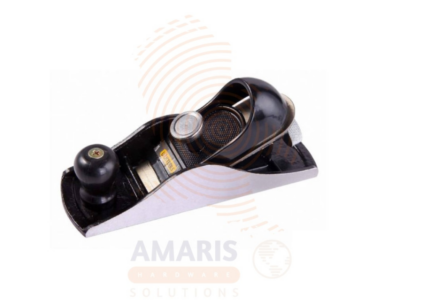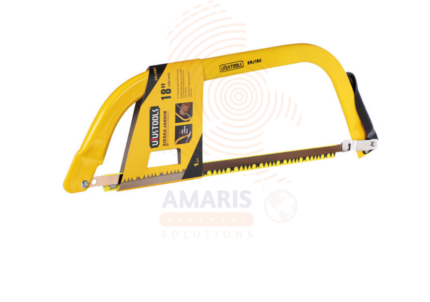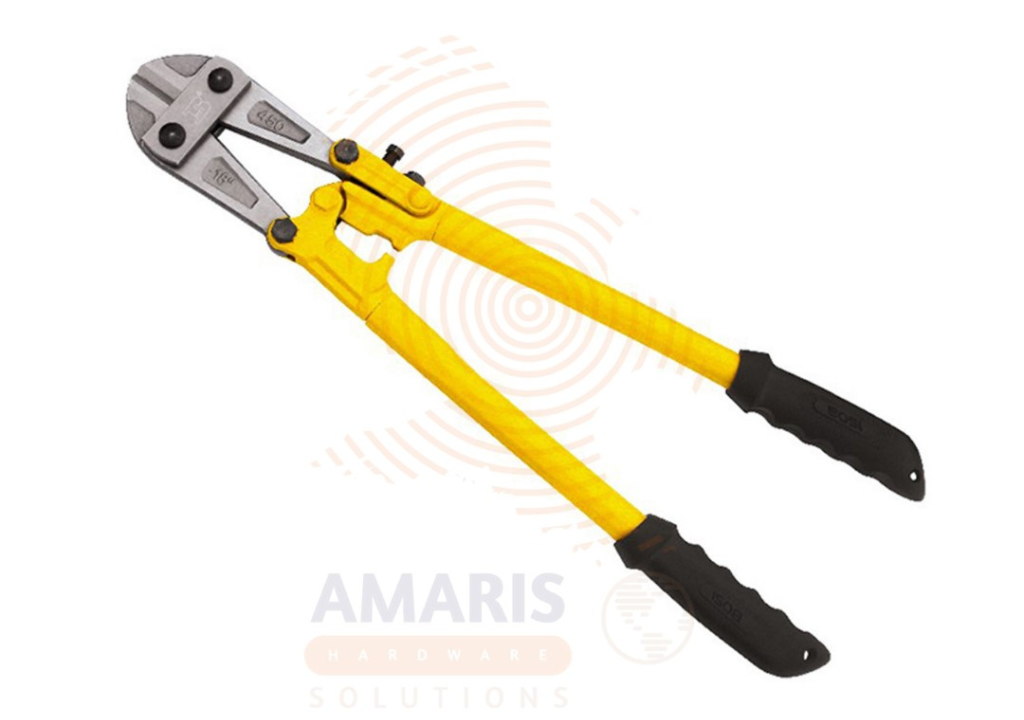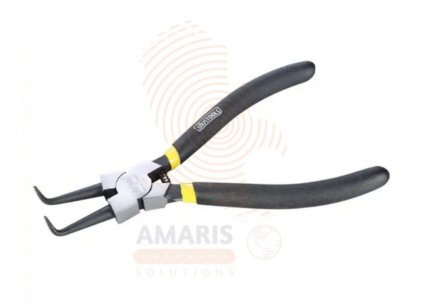
Block Plane
$25.77 Original price was: $25.77.$24.48Current price is: $24.48.

Bow Saw
$17.31 Original price was: $17.31.$16.44Current price is: $16.44.
Bolt Cutter
$63.46 Original price was: $63.46.$60.29Current price is: $60.29.
WhatsApp Order
A bolt cutter is a hand tool designed for cutting through materials such as metal bolts, chains, and wires. It typically consists of two long handles connected at a pivot point, with sharp, strong blades at the opposite end. The handles provide leverage, allowing users to apply force to the blades, effectively cutting through tough materials like bolts or chains with relative ease. Bolt cutters are commonly used in various applications, including construction, maintenance, and emergency situations, where the need to cut through strong and durable materials arises.
Description
Table of Contents
ToggleBolt Cutter
Uses
-
Construction and Maintenance:
-
Cutting through metal bolts, nuts, and screws during construction or maintenance projects.
-
Trimming excess material from steel rods or bars.
-
-
Security and Law Enforcement:
-
Emergency situations where access to locked areas is required, such as cutting padlocks or chains.
-
Law enforcement may use bolt cutters to gain entry or remove barriers when necessary.
-
-
Automotive Repair:
-
Removing damaged or rusted nuts and bolts from vehicles.
-
Cutting through metal components in automotive repair and maintenance.
-
-
Fencing and Wire Work:
-
Cutting through chain-link fences, wires, and cables.
-
Modifying or repairing wire mesh or chain-link fencing.
-
-
Shipping and Warehousing:
-
Opening shipping containers or crates by cutting through metal seals or locks.
-
Handling and cutting steel strapping used in packaging.
-
-
Emergency Situations:
-
Rescuing individuals trapped in vehicles by cutting through metal components.
-
Assisting in disaster response by removing debris or obstacles.
-
-
Home Improvement:
-
DIY projects that involve cutting through metal pipes, rods, or fasteners.
-
Trimming or modifying metal materials for various household applications.
-
-
Recreational Activities:
-
Cutting through metal components for artistic or hobbyist purposes.
-
Modifying or customizing equipment for outdoor activities.
-
-
Industrial and Manufacturing:
-
Cutting through metal bars, rods, or wires in industrial settings.
-
Removing excess material from metal structures during fabrication.
-
-
Utilities Maintenance:
-
Trimming or cutting through metal components in utility poles or structures.
-
Emergency repair work on utility lines or equipment.
-
SAFETY HANDLING PRECAUTIONS
Safety Precautions
-
Personal Protective Equipment (PPE):
-
Wear appropriate PPE, including safety glasses or goggles to protect your eyes from flying debris.
-
Use heavy-duty gloves to protect your hands from sharp edges and prevent blisters.
-
-
Inspect the Bolt Cutter:
-
Before use, inspect the bolt cutter for any damage, such as bent handles, loose joints, or dull blades. Do not use a damaged tool.
-
-
Select the Right Tool for the Job:
-
Choose a bolt cutter that is appropriate for the material you are cutting. Using the wrong tool may result in inefficient cutting or damage to the tool.
-
-
Secure Workpiece:
-
Ensure the material you are cutting is securely clamped or stabilized to prevent movement during the cutting process. This helps maintain control and accuracy.
-
-
Proper Body Position:
-
Stand in a stable and balanced position with your feet shoulder-width apart.
-
Keep your body to the side of the cutting line to avoid being in the path of the cutting blades.
-
-
Use Both Hands:
-
Grip the handles of the bolt cutter with both hands to maximize control and leverage.
-
Use the full length of the handles to apply even pressure, rather than trying to cut with just the tips of the blades.
-
-
Apply Even Pressure:
-
Apply consistent and even pressure on the handles throughout the cutting process.
-
Avoid using excessive force, as it may lead to loss of control or damage to the tool.
-
-
Cut Away from Your Body:
-
Always cut away from your body to prevent injuries in case the tool slips or the material being cut breaks unexpectedly.
-
-
Be Mindful of Surroundings:
-
Be aware of your surroundings, especially if there are other people nearby. Warn others and ensure a safe distance.
-
-
Store Safely:
-
When not in use, store bolt cutters in a secure location, away from children and unauthorized users.
-
Keep the cutting edges protected with blade covers or sheaths to prevent accidental contact.
-
-
Follow Manufacturer's Instructions:
-
Adhere to the manufacturer's guidelines and instructions for the specific bolt cutter model you are using.
-
Related products
Countersink Drill Set
A countersink drill set typically refers to a collection of six tools designed for countersinking operations in woodworking or metalworking. Each set usually includes six individual countersink drills with varying sizes or angles. Countersinking is a process that involves creating a conical hole in a material, allowing the head of a screw or bolt to sit flush with or below the surface. These drill sets are essential for achieving a professional finish in various applications where a smooth and even surface is desired, such as in carpentry, metal fabrication, or DIY projects.
External Circlip Pliers Bent
External circlip pliers – bent refer to a specialized hand tool designed for the installation and removal of external circlips. A circlip, also known as a retaining ring or snap ring, is a type of fastener or retaining device that fits into a groove on a cylindrical object, such as a shaft or a bore. External circlips are positioned on the outside of the shaft or bore.
The term "bent" in the context of external circlip pliers describes the shape of the tool. These pliers typically have angled or bent tips that allow for easier access to the external circlip, especially in tight or confined spaces. The bent design helps the user reach and manipulate the circlip more effectively, providing improved maneuverability during installation or removal.
F-Clamp
An F-clamp, also known as a bar clamp or sliding clamp, is a woodworking tool designed for holding and securing materials in place during the process of gluing, welding, or other similar tasks. It typically consists of two parallel jaws—one fixed and one movable—that can be adjusted along a bar or rail. The movable jaw can be positioned and tightened using a threaded mechanism, allowing the clamp to firmly grip and hold objects of various sizes. F-clamps are widely used in carpentry, metalworking, and other applications where a strong and adjustable clamping force is needed to ensure precision and stability during work.
Flat Hand Steel File
PRODUCT DESCRIPTION
A flat hand file is a type of hand tool used in metalworking and woodworking to remove material from a workpiece by abrasion. It consists of a flat, elongated piece of metal with parallel rows of teeth or ridges, called the file's "cut," which are designed to cut or shape a material when rubbed against it. Flat hand files are typically rectangular in shape and come in various sizes and coarseness grades, allowing for different levels of material removal and finishing. These files are commonly used for smoothing, shaping, and leveling surfaces in a variety of applications, providing a versatile means of material removal in manual craftsmanship.
Flat Head Hex Wrench Set – Short
A Flat Head Hex Wrench Set - Short comprises a collection of seven individual wrenches, each equipped with a flat, straight head and a hexagonal shape at the opposite end. These hex wrenches are specifically designed to engage with and manipulate bolts and screws featuring hexagonal sockets. The set typically includes various sizes, allowing users to select the appropriate wrench for a wide range of applications, making it a versatile and essential tool for tasks that involve assembly, maintenance, or repair work across different industries and settings.
Flat Steel File
PRODUCT DESCRIPTION
A flat steel file is a hand tool used for shaping, smoothing, and removing material from a workpiece, typically made of steel. It consists of a flat, elongated piece of metal with a series of parallel teeth or ridges along one or both of its surfaces. These teeth are designed to cut or abrade material when the file is pushed or pulled across a surface. Flat steel files are commonly used in metalworking, woodworking, and other crafts to achieve precise and smooth finishes on various materials.
Flat Wood File
PRODUCT DESCRIPTION
A flat wood file is a hand tool used for shaping, smoothing, and refining the surfaces of wood. It typically consists of a flat, narrow, rectangular piece of metal with a series of parallel, coarse teeth or ridges along one or both of its sides. These teeth are designed to efficiently remove material when drawn across the wood grain, allowing for the leveling and smoothing of wooden surfaces. Flat wood files are commonly used in woodworking and carpentry for tasks such as shaping edges, refining contours, and removing rough spots on wood surfaces.
Folding Utility Knife
PRODUCT DESCRIPTION
A folding utility knife is a versatile cutting tool characterized by its foldable design, typically featuring a hinged blade that can be retracted into the handle when not in use. This compact and portable knife is commonly employed for various tasks such as cutting materials like cardboard, rope, or packaging, making it a practical tool for both professional and everyday use. The folding mechanism enhances safety during storage and transportation, as it reduces the risk of accidental injuries when the blade is not in use.


 Acrylic Sealants
Acrylic Sealants Construction Adhesives
Construction Adhesives Double-Sided Tape
Double-Sided Tape Duct Tape
Duct Tape Electrical Tape
Electrical Tape Epoxy & Resins
Epoxy & Resins Masking Tape
Masking Tape
 Automotive Wrenches & Socket Sets
Automotive Wrenches & Socket Sets Battery Chargers & Jump Starters
Battery Chargers & Jump Starters Car Jacks & Stands
Car Jacks & Stands Car Wash & Detailing Products
Car Wash & Detailing Products Diagnostic Tools
Diagnostic Tools Tire Inflators
Tire Inflators Vehicle Lighting
Vehicle Lighting Oil & Lubricants
Oil & Lubricants
 Adhesives & Sealants
Adhesives & Sealants Bricks & Blocks
Bricks & Blocks Cement & Concrete
Cement & Concrete Drywall & Plaster
Drywall & Plaster Flooring (Tiles, Wood, Laminate)
Flooring (Tiles, Wood, Laminate) Lumber & Plywood
Lumber & Plywood Paints, Primers & Coatings
Paints, Primers & Coatings Insulation Materials
Insulation Materials Roofing Materials
Roofing Materials
 Circuit Breakers
Circuit Breakers Electrical Cables & Wires
Electrical Cables & Wires Switches & Sockets
Switches & Sockets Fuses & Relays
Fuses & Relays Connectors & Terminals
Connectors & Terminals Electrical Boxes & Panels
Electrical Boxes & Panels Conduit & Fittings
Conduit & Fittings Lighting Fixtures & Bulbs
Lighting Fixtures & Bulbs Extension Cords & Power Strips
Extension Cords & Power Strips
 Anchors
Anchors Bolts
Bolts Clips & Clamps
Clips & Clamps Screws
Screws Nuts
Nuts Washers
Washers Rivets
Rivets Nails
Nails Threaded Rods
Threaded Rods
 Hammers
Hammers Measuring Tools (Tapes, Levels, Calipers)
Measuring Tools (Tapes, Levels, Calipers) Screwdrivers
Screwdrivers Pliers & Cutters
Pliers & Cutters Saws & Blades
Saws & Blades Chisels & Punches
Chisels & Punches Allen Keys & Hex Keys
Allen Keys & Hex Keys Ratchets & Socket Sets
Ratchets & Socket Sets Wrenches & Spanners
Wrenches & Spanners
 Power Tool Accessories (Blades, Bits, Discs)
Power Tool Accessories (Blades, Bits, Discs) Rotary Tools
Rotary Tools Saws (Circular, Jigsaw, Reciprocating)
Saws (Circular, Jigsaw, Reciprocating) Drills & Drivers
Drills & Drivers Grinders & Sanders
Grinders & Sanders Heat Guns
Heat Guns Nail Guns
Nail Guns Impact Wrenches
Impact Wrenches Batteries & Chargers
Batteries & Chargers
 Pipes & Fittings (PVC, Copper, PEX)
Pipes & Fittings (PVC, Copper, PEX) Plumbing Tools
Plumbing Tools Pumps & Motors
Pumps & Motors Sealants & Adhesives for Plumbing
Sealants & Adhesives for Plumbing Valves & Taps
Valves & Taps Water Heaters
Water Heaters Drainage Systems
Drainage Systems Faucets & Fixtures
Faucets & Fixtures Hoses & Tubing
Hoses & Tubing
 Hinges & Latches
Hinges & Latches Hooks & Brackets
Hooks & Brackets Window Hardware
Window Hardware Chains & Cables
Chains & Cables Casters & Wheels
Casters & Wheels Shelving & Storage Systems
Shelving & Storage Systems Door Handles & Locks
Door Handles & Locks Drawer Slides & Cabinet Hardware
Drawer Slides & Cabinet Hardware
 Personal Protective Equipment (PPE)
Personal Protective Equipment (PPE) Respirators & Masks
Respirators & Masks Safety Glasses
Safety Glasses Safes
Safes Security Cameras
Security Cameras Gloves
Gloves Helmets
Helmets Ear Protection
Ear Protection Fire Safety Equipment
Fire Safety Equipment Locks & Padlocks
Locks & Padlocks Motion Sensors & Alarms
Motion Sensors & Alarms
 Garden Fencing
Garden Fencing Garden Furniture Hardware
Garden Furniture Hardware Lawn Mowers
Lawn Mowers Trimmers & Edgers
Trimmers & Edgers Shovels & Spades
Shovels & Spades Rakes & Hoes
Rakes & Hoes Pruning Shears & Loppers
Pruning Shears & Loppers Watering Systems (Hoses, Sprinklers, Nozzles)
Watering Systems (Hoses, Sprinklers, Nozzles)
 Interior Paints
Interior Paints Paint Brushes & Rollers
Paint Brushes & Rollers Paint Strippers & Thinners
Paint Strippers & Thinners Paint Trays & Accessories
Paint Trays & Accessories Exterior Paints
Exterior Paints Spray Paints
Spray Paints Primers & Undercoats
Primers & Undercoats Varnishes & Stains
Varnishes & Stains
 Gaskets & Seals
Gaskets & Seals Hydraulic Fittings
Hydraulic Fittings Industrial Fasteners
Industrial Fasteners Industrial Hoses
Industrial Hoses Lubricants & Greases
Lubricants & Greases Metal Sheets & Bars
Metal Sheets & Bars Bearings & Bushings
Bearings & Bushings Belts & Pulleys
Belts & Pulleys
 HVAC Filters
HVAC Filters Insulation for HVAC
Insulation for HVAC Air Conditioners
Air Conditioners Refrigerants
Refrigerants Ventilation Ducts & Fittings
Ventilation Ducts & Fittings Thermostats & Controllers
Thermostats & Controllers Fans & Blowers
Fans & Blowers
 Pegboards & Hooks
Pegboards & Hooks Shelving Units
Shelving Units Storage Bins & Containers
Storage Bins & Containers Toolboxes & Tool Chests
Toolboxes & Tool Chests Workbenches
Workbenches Drawer Organizers
Drawer Organizers Labeling Supplies
Labeling Supplies
 Welding Accessories (Clamps, Brushes)
Welding Accessories (Clamps, Brushes) Welding Electrodes & Rods
Welding Electrodes & Rods Welding Helmets & Gloves
Welding Helmets & Gloves Welding Machines
Welding Machines Soldering Irons & Stations
Soldering Irons & Stations Flux & Solder Wire
Flux & Solder Wire
 Generator Accessories
Generator Accessories Inverters
Inverters Portable Generators
Portable Generators Power Inverters
Power Inverters Transfer Switches
Transfer Switches Diesel & Gasoline Generators
Diesel & Gasoline Generators
 Transport Equipment: Carts, Dollies, and Hand Trucks
Transport Equipment: Carts, Dollies, and Hand Trucks Storage Solutions: Pallets, Racks, and Containers
Storage Solutions: Pallets, Racks, and Containers Lifting Equipment: Hoists, Cranes, and Jacks
Lifting Equipment: Hoists, Cranes, and Jacks Conveyors and Accessories: Belts and Rollers
Conveyors and Accessories: Belts and Rollers







